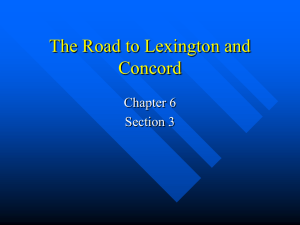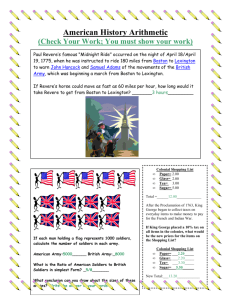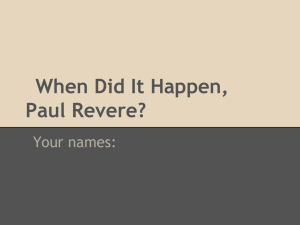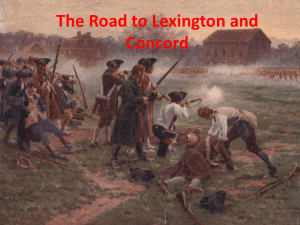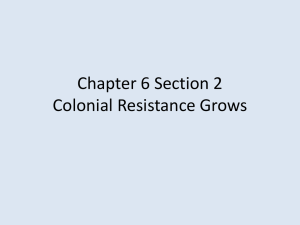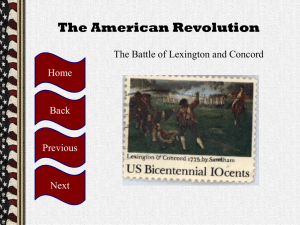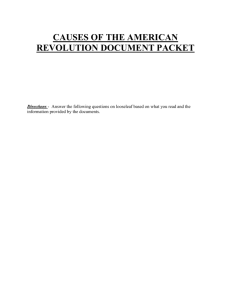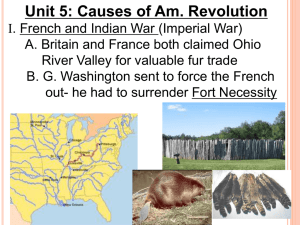Events that led to The American Revolution Review
advertisement
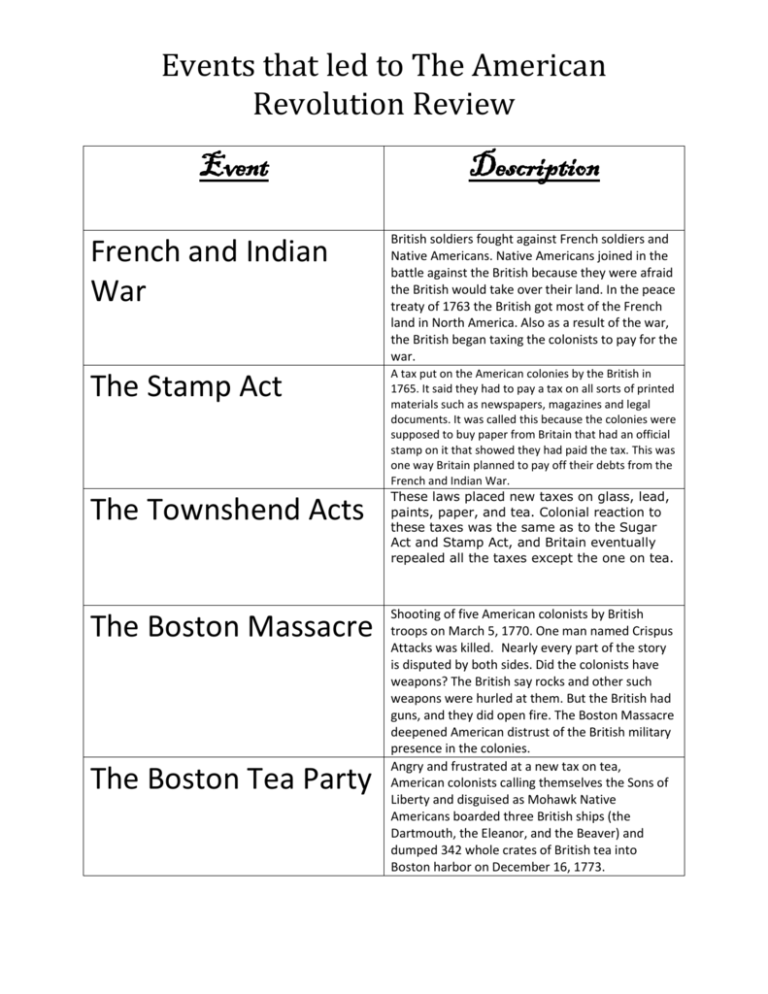
Events that led to The American Revolution Review Event Description French and Indian War British soldiers fought against French soldiers and Native Americans. Native Americans joined in the battle against the British because they were afraid the British would take over their land. In the peace treaty of 1763 the British got most of the French land in North America. Also as a result of the war, the British began taxing the colonists to pay for the war. The Stamp Act A tax put on the American colonies by the British in 1765. It said they had to pay a tax on all sorts of printed materials such as newspapers, magazines and legal documents. It was called this because the colonies were supposed to buy paper from Britain that had an official stamp on it that showed they had paid the tax. This was one way Britain planned to pay off their debts from the French and Indian War. These laws placed new taxes on glass, lead, paints, paper, and tea. Colonial reaction to these taxes was the same as to the Sugar Act and Stamp Act, and Britain eventually repealed all the taxes except the one on tea. The Townshend Acts The Boston Massacre The Boston Tea Party Shooting of five American colonists by British troops on March 5, 1770. One man named Crispus Attacks was killed. Nearly every part of the story is disputed by both sides. Did the colonists have weapons? The British say rocks and other such weapons were hurled at them. But the British had guns, and they did open fire. The Boston Massacre deepened American distrust of the British military presence in the colonies. Angry and frustrated at a new tax on tea, American colonists calling themselves the Sons of Liberty and disguised as Mohawk Native Americans boarded three British ships (the Dartmouth, the Eleanor, and the Beaver) and dumped 342 whole crates of British tea into Boston harbor on December 16, 1773. Events that led to The American Revolution Review The Intolerable Acts The Quartering Acts Series of laws sponsored by British Prime Minister Lord North and enacted in 1774 in response to the Boston Tea Party. One of the Intolerable acts which allowed royal troops to stay in houses or empty buildings if barracks were not available Continental Congress meeting in Philadelphia A group of 56 delegates from 12 colonies (all except Georgia) who met in Philadelphia in September of 1774. They came together to act together in response to the Intolerable Acts. They met in secret because they didn't want Great Britain to know that they were united. Lexington Town where John Hancock and Samuel Adams were staying in order to avoid being caught by the British since they were wanted men. Concord Town where weapons were being stored. Midnight Ride On the evening of April 18, 1775, Paul Revere was sent for by Dr. Joseph Warren and instructed to ride to Lexington, Massachusetts, to warn Samuel Adams and John Hancock that British troops were marching to arrest them. After being rowed across the Charles River to Charlestown by two associates, Paul Revere borrowed a horse from his friend Deacon John Larkin. While in Charlestown, he verified that the local "Sons of Liberty" committee had seen his pre-arranged signals. (Two lanterns had been hung briefly in the bell-tower of Christ Church in Boston, indicating that troops would row "by sea" across the Charles River to Cambridge, rather than marching "by land" out Boston Neck. Revere had arranged for these signals the previous weekend, Events that led to The American Revolution Review as he was afraid that he might be prevented from leaving Boston). On the way to Lexington, Revere "alarmed" the country-side, stopping at each house, and arrived in Lexington about midnight. As he approached the house where Adams and Hancock were staying, a sentry asked that he not make so much noise. "Noise!" cried Revere, "You'll have noise enough before long. The regulars are coming out!" After delivering his message, Revere was joined by a second rider, William Dawes, who had been sent on the same errand by a different route. Deciding on their own to continue on to Concord, Massachusetts, where weapons and supplies were hidden, Revere and Dawes were joined by a third rider, Dr. Samuel Prescott. Soon after, all three were arrested by a British patrol. Prescott escaped almost immediately, and Dawes soon after. Revere was held for some time and then released. Left without a horse, Revere returned to Lexington in time to witness part of the battle on the Lexington Green. Shot Heard ‘Round the World First shots fired between American and British troops, on April 19, 1775. The British chose to march to Concord because it was an arms depot. This meant that the Americans had stockpiled weapons there. British troops had occupied Boston and were marching on Concord as they passed through Lexington. No one is still sure who fired first, but it was the "Shot Heard 'Round the World." Both sides opened fire, and the Americans were forced to withdraw. But they had slowed the British advance. By the time the Redcoats got to Concord, the Americans were waiting for them in force. The weapons depot was saved, and the British were forced to retreat, harassed by militiamen along the way.
